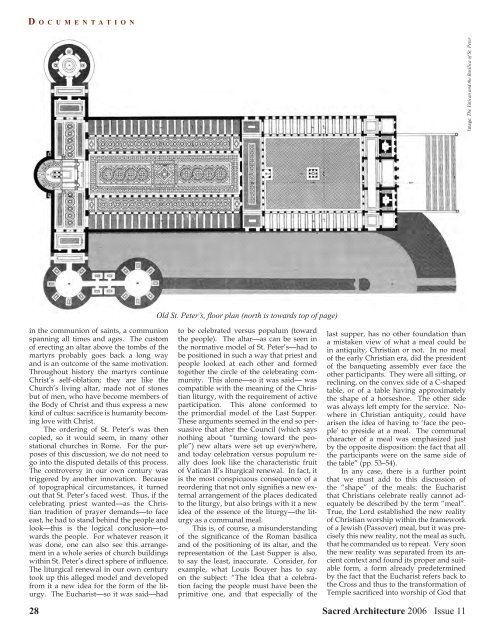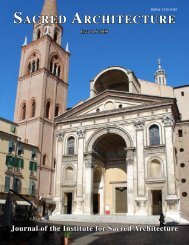Download Issue PDF - The Institute for Sacred Architecture
Download Issue PDF - The Institute for Sacred Architecture
Download Issue PDF - The Institute for Sacred Architecture
You also want an ePaper? Increase the reach of your titles
YUMPU automatically turns print PDFs into web optimized ePapers that Google loves.
D O C U M E N T A T I O N<br />
in the communion of saints, a communion<br />
spanning all times and ages. <strong>The</strong> custom<br />
of erecting an altar above the tombs of the<br />
martyrs probably goes back a long way<br />
and is an outcome of the same motivation.<br />
Throughout history the martyrs continue<br />
Christ’s self-oblation; they are like the<br />
Church’s living altar, made not of stones<br />
but of men, who have become members of<br />
the Body of Christ and thus express a new<br />
kind of cultus: sacrifice is humanity becoming<br />
love with Christ.<br />
<strong>The</strong> ordering of St. Peter’s was then<br />
copied, so it would seem, in many other<br />
stational churches in Rome. For the purposes<br />
of this discussion, we do not need to<br />
go into the disputed details of this process.<br />
<strong>The</strong> controversy in our own century was<br />
triggered by another innovation. Because<br />
of topographical circumstances, it turned<br />
out that St. Peter’s faced west. Thus, if the<br />
celebrating priest wanted—as the Christian<br />
tradition of prayer demands—to face<br />
east, he had to stand behind the people and<br />
look—this is the logical conclusion—towards<br />
the people. For whatever reason it<br />
was done, one can also see this arrangement<br />
in a whole series of church buildings<br />
within St. Peter’s direct sphere of influence.<br />
<strong>The</strong> liturgical renewal in our own century<br />
took up this alleged model and developed<br />
from it a new idea <strong>for</strong> the <strong>for</strong>m of the liturgy.<br />
<strong>The</strong> Eucharist—so it was said—had<br />
Old St. Peter’s, floor plan (north is towards top of page)<br />
to be celebrated versus populum (toward<br />
the people). <strong>The</strong> altar—as can be seen in<br />
the normative model of St. Peter’s—had to<br />
be positioned in such a way that priest and<br />
people looked at each other and <strong>for</strong>med<br />
together the circle of the celebrating community.<br />
This alone—so it was said— was<br />
compatible with the meaning of the Christian<br />
liturgy, with the requirement of active<br />
participation. This alone con<strong>for</strong>med to<br />
the primordial model of the Last Supper.<br />
<strong>The</strong>se arguments seemed in the end so persuasive<br />
that after the Council (which says<br />
nothing about “turning toward the people”)<br />
new altars were set up everywhere,<br />
and today celebration versus populum really<br />
does look like the characteristic fruit<br />
of Vatican II’s liturgical renewal. In fact, it<br />
is the most conspicuous consequence of a<br />
reordering that not only signifies a new external<br />
arrangement of the places dedicated<br />
to the liturgy, but also brings with it a new<br />
idea of the essence of the liturgy—the liturgy<br />
as a communal meal.<br />
This is, of course, a misunderstanding<br />
of the significance of the Roman basilica<br />
and of the positioning of its altar, and the<br />
representation of the Last Supper is also,<br />
to say the least, inaccurate. Consider, <strong>for</strong><br />
example, what Louis Bouyer has to say<br />
on the subject: “<strong>The</strong> idea that a celebration<br />
facing the people must have been the<br />
primitive one, and that especially of the<br />
last supper, has no other foundation than<br />
a mistaken view of what a meal could be<br />
in antiquity, Christian or not. In no meal<br />
of the early Christian era, did the president<br />
of the banqueting assembly ever face the<br />
other participants. <strong>The</strong>y were all sitting, or<br />
reclining, on the convex side of a C-shaped<br />
table, or of a table having approximately<br />
the shape of a horseshoe. <strong>The</strong> other side<br />
was always left empty <strong>for</strong> the service. Nowhere<br />
in Christian antiquity, could have<br />
arisen the idea of having to ‘face the people’<br />
to preside at a meal. <strong>The</strong> communal<br />
character of a meal was emphasized just<br />
by the opposite disposition: the fact that all<br />
the participants were on the same side of<br />
the table” (pp. 53–54).<br />
In any case, there is a further point<br />
that we must add to this discussion of<br />
the “shape” of the meals: the Eucharist<br />
that Christians celebrate really cannot adequately<br />
be described by the term “meal”.<br />
True, the Lord established the new reality<br />
of Christian worship within the framework<br />
of a Jewish (Passover) meal, but it was precisely<br />
this new reality, not the meal as such,<br />
that he commanded us to repeat. Very soon<br />
the new reality was separated from its ancient<br />
context and found its proper and suitable<br />
<strong>for</strong>m, a <strong>for</strong>m already predetermined<br />
by the fact that the Eucharist refers back to<br />
the Cross and thus to the trans<strong>for</strong>mation of<br />
Temple sacrificed into worship of God that<br />
28 <strong>Sacred</strong> <strong>Architecture</strong> 2006 <strong>Issue</strong> 11<br />
Image: <strong>The</strong> Vatican and the Basilica of St. Peter










